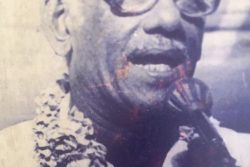Wayne Brown is a well-known Trinidadian writer and columnist who now lives in Jamaica. This is the 29th in his new series on the Obama era.
aTo ideologues, they’re what’s wrong with democracy; to others, they’re what gives the process stability, protects it from extremists of the right and left, and tethers it to common sense and decency.
We are talking about the Silent Majority, a phrase popularized by Richard Nixon to argue — accurately, as it turned out — that, beneath the media-hallowed dramas of the American ’60s (the assassinations of the Kennedys, Malcolm and MLK, the anti-war demonstrations and flag-burnings, Stokely and the Black Panthers, the hippies with their drug culture) there abided a much larger society of ‘decent’ Americans who seldom had anything to say publicly about what was taking place in their country, but who thoroughly disapproved of most of it, and whose power would make itself felt at the voting booth.
As it did. Massively supported by the Silent Majority, Nixon won 49 out of the 50 states in 1972.
But Nixon also used the phrase invidiously, to include the objects of his ‘Southern Strategy’; as a coded reference, that is, to the great shifts in political allegiance that erupted upon Lyndon Johnson’s enactment of civil rights and voting rights legislation. While African-Americans moved to the Democratic Party as a result, a great many southern white racist Democrats, descendants of the Dixiecrats, abandoned their party in disgust to vote Republican from then on.
The phrase the Silent Majority was thus complicated from the outset by the inclusion of the constituency of the Southern Strategy. And the code phrases for what moved the latter were ‘states rights’ (meaning, in effect, segregation) and ‘law and order’ (meaning coming down hard on social unrest and mainly-black crime in the inner cities).
One such type, generically dubbed ‘Bubba,’ was later typified by a comic writer in Playboy as forever sitting in front of the TV sardonically commenting on the news. (‘That’s right: y’all lie down in the street now.’)
So the Silent Majority, back in the ’70s and ’80s, included both decent citizens from the American heartland and Southern whites fighting a rearguard action against racial integration. (The phrase ‘the guns-’n-churches crowd’ includes both wings.) The decent constituency was large enough that when, appalled by Watergate, it turned its back on the party of Nixon, it went outside of the system to elect a little-known Georgia Democrat, Jimmy Carter, in 1976. But it soon closed ranks again with the ‘Dixiecrats’ to elect Ronald Reagan, who campaigned on a platform of states’ rights, just as his successor, George Herbert Walker Bush, played the law and order card with his infamous Willie Horton ad.
More recently, the Republicans’ Southern Strategy has evolved to include championing ‘cultural values,’ mainly, support of gun ownership and (linking arms here with the ‘decent’ wing of the Silent Majority) opposition to gay rights and abortion.
But racism has remained at its core. By the era of GW Bush, the Republican Party was overwhelmingly white (never mind those Negro puppets, Colin Powell and Condoleezza Rice, obligingly pushed to the front of the store window), and it has never lacked for coded ways to signal this.
In 2006, the RNC bought an ad featuring a young white woman, shot from an angle that made her appear naked, reminding the black Democratic Senatorial candidate Harold Ford Jnr via his answering machine of the fun they’d had at a ‘Playboy’ party and huskily inviting him to ‘Call me.’ Ford narrowly lost that election.
Last year, the McCain campaign tried for a repeat of that gambit when it sought to link Obama to those promiscuous blonde bimbos, Paris Hilton and Britney Spears, but the Teflon Kid brushed it off.
Last year, too, the RNC, at its convention, managed the astonishing feat of parading on stage a dozen members of the armed services, and a dozen past medal-winning Olympians, with not a single one of them being black. (As can be imagined, they had to scrape the barrel for those white Olympians: 45-year-old ex-gymnasts and the like.)
The point is that, till recently, the Silent Majority was neither homogenously good nor bad, but a mix of decent folk and recalcitrant white racists. But that’s changed of late.
The turning point was Katrina. Nine months earlier, the Silent Majority, still driven by 9/11 and the belief that Bush was a ‘strong’ president who would keep them safe, had fought off their growing unease over Iraq and their deep shock at Abu Ghraib and re-elected Bush-Cheney. But Katrina was a national disgrace that thoroughly shamed them. And there were other things they couldn’t ignore, either: the revealed corruption of so many Republican Congressmen, the fiscal irresponsibility of the Bush regime, and the government snooping into their lives, what with the library cards’ business and the warrantless wiretapping.
In last year’s election, the Silent Majority split into its constituents. The objects of the Southern Strategy, the po’white racists, once again voted Republican (though not all of them; one recalls, memorably, a rural Indiana redneck telling a canvasser “We’re voting for the nigger” [sic!]). But the decent folk turned away in disgust from the party after 30 years, and demographic changes did the rest. Obama swept to the biggest Democratic victory in 44 years.
In a word, the decent wing of the Silent Majority was sufficiently appalled by the excrescences of the Bush-Cheney years to switch allegiance, and they are the reliable ballast that today gives Obama approval ratings consistently in the 60s, more than enough to empower him to face down the shrill Republicans in Congress and push through his mainly left-of-centre policies. The decent wing of the Silent Majority has decided that it trusts Obama, and therein lies his power.
It’s important to realize this, because those who, like this columnist, get their news of the US political scene overwhelmingly from the US media, can easily forget that the media is by nature a great leveller, and in the interests of ‘drama,’ of construing a ‘horserace,’ will often give as much airplay to a rightwing airhead like Sarah Palin, or a ‘controversial’ buffoon like Rush Limbaugh, as to the president and his cohorts.
That can be a bad distortion of actuality. The Silent Majority rejected McCain precisely because of their assessment of Palin.
And that’s the moral of this column. If at any given moment you want to know the political mood of America, take the talk shows and newspaper columns with a grain of salt, and trust the polls instead. They are where the Silent Majority make their views known. And it’s their views, not Bill O’Reilly’s or Chris Matthews’ that decide political fortunes at election time.









